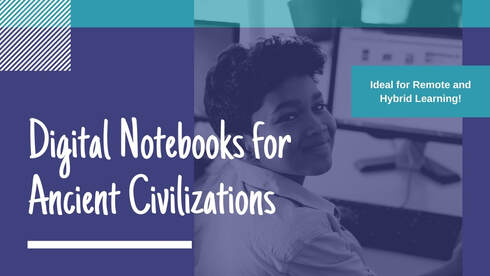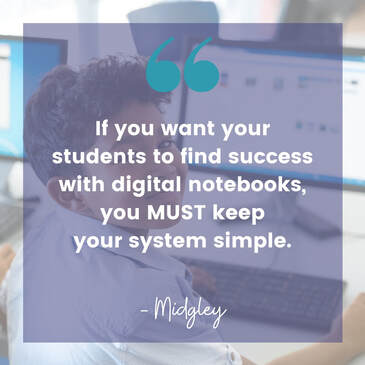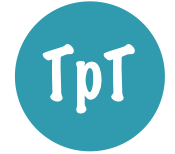Digital Notebooks for
Ancient Civilizations Made Easy
Figuring out how to teach ancient civilizations with remote learning can be overwhelming. How can you make it comprehensive, yet straight forward for your students to understand?
It feels like lesson planning overload all over again. Even if you’ve been teaching the curriculum for a few years, throwing in the digital element can knock you off balance. There’s so much pressure to make things fancy and entertaining. When you are really just trying to find the best way to teach your students without losing your sanity.
And if you’re a big fan of notebooks in your classroom like I am, there’s an extra frustration. How can you get the advantages of a notebook when you’re teaching through a camera and everything students do is on a screen? For an old-schoolie like me, who believes in the pencil to paper, digital instruction leaves another downfall in its wake.
But digital instruction doesn’t have to be fancy to be effective and engaging. Creating a resource that is engaging, straight forward and comprehensive has become the goal in terms of digital learning.
In this post, I’m going to share with you how I’ve simplified my digital notebooks for ancient civilizations.
It feels like lesson planning overload all over again. Even if you’ve been teaching the curriculum for a few years, throwing in the digital element can knock you off balance. There’s so much pressure to make things fancy and entertaining. When you are really just trying to find the best way to teach your students without losing your sanity.
And if you’re a big fan of notebooks in your classroom like I am, there’s an extra frustration. How can you get the advantages of a notebook when you’re teaching through a camera and everything students do is on a screen? For an old-schoolie like me, who believes in the pencil to paper, digital instruction leaves another downfall in its wake.
But digital instruction doesn’t have to be fancy to be effective and engaging. Creating a resource that is engaging, straight forward and comprehensive has become the goal in terms of digital learning.
In this post, I’m going to share with you how I’ve simplified my digital notebooks for ancient civilizations.
Why Digital Notebooks
Let’s go back to why we love notebooks to begin with. They’re an ideal tool for allowing students to process information and teach them organization skills at the same time. Not to mention they serve as excellent study tools for students.
When I started teaching, I always loved using notebooks, but never really gave it any thought to the structure of the notebook itself. When I first researched Interactive Student Notebooks years ago, I discovered many in science, but very few in social studies. I think it’s fair to say that that has changed in recent years... which is great because that means more students are getting the benefit of notebooks!
As I built my own system, I adapted concepts from science interactive notebooks to my social studies class. Using a structure to plan out my notebook activities made lesson planning so much easier once I got the hang of it.
When I started teaching, I always loved using notebooks, but never really gave it any thought to the structure of the notebook itself. When I first researched Interactive Student Notebooks years ago, I discovered many in science, but very few in social studies. I think it’s fair to say that that has changed in recent years... which is great because that means more students are getting the benefit of notebooks!
As I built my own system, I adapted concepts from science interactive notebooks to my social studies class. Using a structure to plan out my notebook activities made lesson planning so much easier once I got the hang of it.
Organization Skills
Notebooks are an excellent vessel for helping students learn organization skills. And as we all know, our middle schoolers need as much help as they can get!
The structure of using page numbers, dates, and titles at the top of each page helps students learn good habits for any type of learning activity.
Even students who struggle with comprehending content, can find success with their notebook organization. This boost in confidence can help them feel good about your class (as opposed to dreading something that’s hard) and allow them to go on to find success.
These skills will also carry over into other classes. One student of mine went on to use this notebook system when they were in 7th grade. When a teacher asked about what they were doing, he replied, “I learned to take notes like this in Ms. Midgley’s class. It really helps me so I do it in all my classes now.”
If that isn’t a win, I don’t know what is!
Digital notebooks can help students with organization too. It just looks a little bit different.
You can easily create a notebook by putting together a collection of Google Slides.
Obviously, you won’t want to give them 20 slides at once for the entire unit. You’ll want to give them one at a time, as they need them. After completion, students can keep them together in a particular file, in a particular order.
The structure of using page numbers, dates, and titles at the top of each page helps students learn good habits for any type of learning activity.
Even students who struggle with comprehending content, can find success with their notebook organization. This boost in confidence can help them feel good about your class (as opposed to dreading something that’s hard) and allow them to go on to find success.
These skills will also carry over into other classes. One student of mine went on to use this notebook system when they were in 7th grade. When a teacher asked about what they were doing, he replied, “I learned to take notes like this in Ms. Midgley’s class. It really helps me so I do it in all my classes now.”
If that isn’t a win, I don’t know what is!
Digital notebooks can help students with organization too. It just looks a little bit different.
You can easily create a notebook by putting together a collection of Google Slides.
Obviously, you won’t want to give them 20 slides at once for the entire unit. You’ll want to give them one at a time, as they need them. After completion, students can keep them together in a particular file, in a particular order.
Processing Time
I’m a big believer that students need opportunity to process and work with information before being “graded” on how well they completed a task. This is where notebooks come in for the win.
Any activity done in class is considered an opportunity to learn and process. There is very little that we do in class that is graded – unless it’s a culminating activity.
Now you might be thinking.... Huh? But hear me out!
You can’t just present information to students and then expect them to immediately perform. They need time to work with the material and process it.
This is what I’m talking about. Students are presented with new content (maybe it’s whole class, small group, in partners, or individually) and then they are given the chance to work with the information and process it in their notebooks.
Sometimes that processing looks like writing summaries, graphic organizers, guided notes, diagrams, short answers, vocabulary work, map work, etc.
I’m not going to grade students on whether or not they processed information correctly... because learning is a process.
The notebook provides opportunity to work through and understand content. Which helps make students ready to perform on more culminating tasks like projects and assessments where they are graded for accuracy.
Digital notebooks allow for the same processing. It provides students with a place to work with the content to further their understanding.
Any activity done in class is considered an opportunity to learn and process. There is very little that we do in class that is graded – unless it’s a culminating activity.
Now you might be thinking.... Huh? But hear me out!
You can’t just present information to students and then expect them to immediately perform. They need time to work with the material and process it.
This is what I’m talking about. Students are presented with new content (maybe it’s whole class, small group, in partners, or individually) and then they are given the chance to work with the information and process it in their notebooks.
Sometimes that processing looks like writing summaries, graphic organizers, guided notes, diagrams, short answers, vocabulary work, map work, etc.
I’m not going to grade students on whether or not they processed information correctly... because learning is a process.
The notebook provides opportunity to work through and understand content. Which helps make students ready to perform on more culminating tasks like projects and assessments where they are graded for accuracy.
Digital notebooks allow for the same processing. It provides students with a place to work with the content to further their understanding.
Notebooks for Studying
Why does anyone take notes in the first place?
Pretty sure the reason is to help them remember and learn something new.
How often do you take notes from an article or a book and then never look at those notes again?
If this is you, or your students, then I’m sorry to be the one to tell you this, but...
You’re doing it wrong.
Your students should be referencing back to their notebook regularly.
Maybe it’s to read the summary from the previous lesson in order to prepare their mind for the next lesson.
Maybe it’s to go look up the definition to that new vocabulary word that they just can’t remember yet.
Maybe it’s to find who that one guy was who created the first empire.
These are just a few examples of how you and your students should be using your notebooks on a daily basis.
Then when it comes time to prepare for the test, the notebook gives students something to work with when they go to practice with their study guide.
Digital notebooks work the same way. Instead of it being a physical notebook they can flip through, students use an on-going digital file.
Pretty sure the reason is to help them remember and learn something new.
How often do you take notes from an article or a book and then never look at those notes again?
If this is you, or your students, then I’m sorry to be the one to tell you this, but...
You’re doing it wrong.
Your students should be referencing back to their notebook regularly.
Maybe it’s to read the summary from the previous lesson in order to prepare their mind for the next lesson.
Maybe it’s to go look up the definition to that new vocabulary word that they just can’t remember yet.
Maybe it’s to find who that one guy was who created the first empire.
These are just a few examples of how you and your students should be using your notebooks on a daily basis.
Then when it comes time to prepare for the test, the notebook gives students something to work with when they go to practice with their study guide.
Digital notebooks work the same way. Instead of it being a physical notebook they can flip through, students use an on-going digital file.
Keeping It Simple
We’ve all heard the KISS acronym right? Keep It Simple S... I’ll refrain from the last word, but you get my meaning.
If you want your students to find success with digital notebooks – which I assume you do since you are reading this article! You MUST keep your digital notebook system simple.
I’ve seen so many teachers on social media (especially) showcasing these fancy slides with moving parts.
Don’t get me wrong, they look AMAZING. And I can only imagine the energy put into creating them.
But let me ask you, is it going to be easy for your students to navigate?
Can they easily go back and reference information?
If not, then aren’t you defeating the purpose?
You can make it engaging yet still keep it simple.
You’ll save yourself hours of headache and your students will find more success.
If you want your students to find success with digital notebooks – which I assume you do since you are reading this article! You MUST keep your digital notebook system simple.
I’ve seen so many teachers on social media (especially) showcasing these fancy slides with moving parts.
Don’t get me wrong, they look AMAZING. And I can only imagine the energy put into creating them.
But let me ask you, is it going to be easy for your students to navigate?
Can they easily go back and reference information?
If not, then aren’t you defeating the purpose?
You can make it engaging yet still keep it simple.
You’ll save yourself hours of headache and your students will find more success.
Easy Digital Notebooks with Google Slides
To create a digital notebook with google slides for my ancient civilizations curriculum, I took a 3 step approach.
First, I looked at what I had done in the past with regular notebooks. Obviously, the same type of content was needed in the digital version.
While some exercises easily transferred to a digital version, others did not.
Once I transferred over all the exercises and activities that were easy to make digital, I looked at what I had as a whole.
Was there enough to cover all of the major objectives of the unit? If not, then something new would have to be developed to meet the objectives that were missing.
Ultimately, the goal was to have at least one digital page (or slide) that addressed each of the major learning objectives for the unit.
First, I looked at what I had done in the past with regular notebooks. Obviously, the same type of content was needed in the digital version.
While some exercises easily transferred to a digital version, others did not.
Once I transferred over all the exercises and activities that were easy to make digital, I looked at what I had as a whole.
Was there enough to cover all of the major objectives of the unit? If not, then something new would have to be developed to meet the objectives that were missing.
Ultimately, the goal was to have at least one digital page (or slide) that addressed each of the major learning objectives for the unit.
Simplifying Ancient Civilizations
When you first start teaching ancient civilizations, it can be extremely overwhelming. Even if your district has adopted curriculum with a textbook, very few are organized in a way that provides clear structure for what you’re teaching.
The one exception I’ve come across, is the History Alive! Curriculum by TCI. In fact, their materials were part of my inspiration for developing my 7 part structure for teaching ancient civilizations.
While it may be tempting to dive in and do elaborate projects about the olympics or the pyramids, remember your first goal is always to cover the core learning objectives. Once you’ve done that, then you can dive into whatever aspect you like with whatever extra time you have.
So what are the core learning objectives for ancient civilizations? This is where my 7 part structure comes in. When you teach using this structure, so many things become easier and less stressful.
Teaching with a framework makes it easier for you and your students. You will be amazed at how much easier it is to lesson plan. The units will practically lay themselves out on the calendar for you. You’ll be able to teach with confidence, knowing that you are covering all the required components. Streamlined teaching at its finest.
Your students will soar with success. The framework will eliminate so much stress for them. When I was a student, history class always stressed me out because I had no idea what I was supposed to be learning or what was important to know. The 7 part structure takes care of all that.
Your students will know exactly what is expected of them and you’ll find their confidence levels sky rocket as their assessment performance improves.
Make no mistake – you are not “dumbing down” your curriculum. You are simply organizing it a way that makes it easier to understand.
The one exception I’ve come across, is the History Alive! Curriculum by TCI. In fact, their materials were part of my inspiration for developing my 7 part structure for teaching ancient civilizations.
While it may be tempting to dive in and do elaborate projects about the olympics or the pyramids, remember your first goal is always to cover the core learning objectives. Once you’ve done that, then you can dive into whatever aspect you like with whatever extra time you have.
So what are the core learning objectives for ancient civilizations? This is where my 7 part structure comes in. When you teach using this structure, so many things become easier and less stressful.
Teaching with a framework makes it easier for you and your students. You will be amazed at how much easier it is to lesson plan. The units will practically lay themselves out on the calendar for you. You’ll be able to teach with confidence, knowing that you are covering all the required components. Streamlined teaching at its finest.
Your students will soar with success. The framework will eliminate so much stress for them. When I was a student, history class always stressed me out because I had no idea what I was supposed to be learning or what was important to know. The 7 part structure takes care of all that.
Your students will know exactly what is expected of them and you’ll find their confidence levels sky rocket as their assessment performance improves.
Make no mistake – you are not “dumbing down” your curriculum. You are simply organizing it a way that makes it easier to understand.
Ready To Roll Materials
Now that you know the why and how behind developing digital notebooks for ancient civilizations, you are ready to go create your own!
But if you feel like it would be easier, you can always grab my done-for-you digital notebooks for ancient civilizations from my Teachers Pay Teachers store.
You can purchase each unit individually, or all of them at once in the money saving bundle.
Happy Teaching!
But if you feel like it would be easier, you can always grab my done-for-you digital notebooks for ancient civilizations from my Teachers Pay Teachers store.
You can purchase each unit individually, or all of them at once in the money saving bundle.
Happy Teaching!
You May Also Like...
Let's Connect...

Welcome! I'm Hillary Midgley, a veteran 6th grade teacher.
I create educational materials and develop curriculum for other teachers. I specialize in teaching students how to learn through my Study Skills Curriculum. I have established fundamental classroom systems and structures for teachers to help them streamline their classroom. And my passion is teaching ancient history through engaging activities with foundations in academic skills. Here you will find resources on all of these topics and more. Learn more about me here.
|











